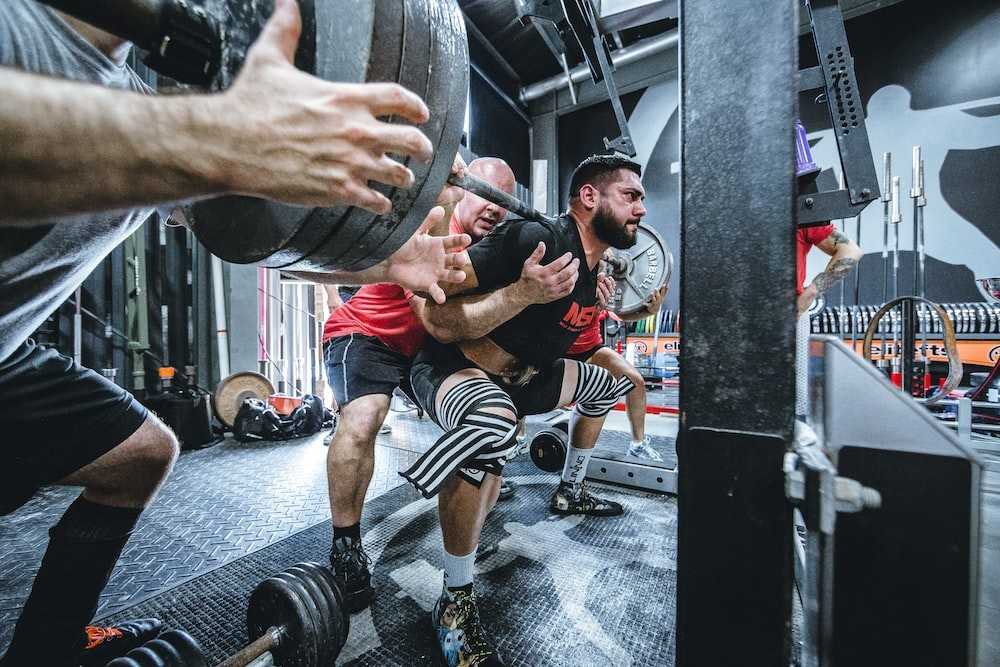Supersets in simplest of the terms means ‘performing two different exercises back to back with minimal rest in between’. It was the Weider school of training which popularized the concept of Supersets, claiming that ‘more work can be done in less time’.

Supersets are of different types:
- Paired/Reciprocal Supersets – involves doing an exercise for a particular muscle group (agonist), followed by an exercise for the antagonist (opposite) muscle group. For e.g. doing a set of Barbell Squats targeting mainly quadriceps (agonist) & immediately doing a set of Leg Curls for hamstring (antagonist).
This type of superset is preferred more as the peripheral fatigue, the type that develops in the muscle being used, is less, due to opposing muscles being trained. But the overall cumulative or central fatigue is still quite high.
2. Staggered Supersets – involved doing a set of an exercise for a muscle group, followed by another set of an exercise of an unrelated muscle group. Or, a set of barbell squats followed by a set of Dumbbell Pullovers.
3. Compound Supersets – involves doing two exercises for the same muscle group back to back. These are further divided into 2 types:
- Pre-Exhaust Supersets – involves performing an isolation exercise followed by a compound exercise, for the same muscle group. For e.g. doing a set of leg extensions, followed by a set of Barbell Squats or Leg Press.
- Post-Exhaust Supersets – involves performing a compound exercise followed by an isolation exercise, for the same muscle group. For e.g. doing a set of barbell squats, followed by a set of leg extensions.
Of course, the primary advantage of a Superset is more work performed in a shorter period of time. A study, suggested that supersets could constitute a more time-efficient training method than the traditional sets since it allows optimizing training time without compromising acute neuromuscular performance over the training session. This occurs, at least, when both combined exercises are conducted with moderate relative loads (55–70% 1RM) and a moderate degree of fatigue.
A study on athletes, found that, for the same loads, supersets induces similar jump and strength improvements, but in a more time-efficient manner, than the traditional approach.
Supersets are an excellent way to increase anabolic hormones like growth hormones and testosterone, due to shorter rest between sets and higher intensity. In a study, group that rested 1 minute between sets (superset group) had 25% higher testosterone levels immediately after the workout than the group that rested 2.5 minutes per between sets.
Because, supersets greatly boosts the intensity of the workout, and therefore can be quite demanding.

A study examined the effect of Paired/Reciprocal Superset, on 18 resistance trained individuals. This superset was found to be extremely metabolically demanding that may elicit increases in musculoskeletal, cardiorespiratory, and physiological adaptations while decreasing the duration of exercise.
In the study, Paired/Reciprocal Supersets increased oxygen uptake, heart rate, blood lactate levels, RPE (Rate of Perceived Exertion), excess post-exercise oxygen consumption (EPOC), and aerobic & anaerobic energy expenditure.
When comparing the 3 different types of supersets, a study assessed the effect of all 3 types on rate of perceived exertion (RPE), kinetic and kinematic changes during the bench press. The study found that, RPE was greater in staggered and compound type supersets than Reciprocal supersets. Also, compound supersets had the greatest reduction in peak force and power.
Because of the higher intensity of Supersets, cumulative fatigue is very high. And higher fatigue over multiple supersets may hinder your ability to maintain the correct form while performing the exercise. That’s why, one should be conditioned enough in order to handle the load & demands of supersets.
Also, make sure you take adequate rest between two supersets. The rest will be in proportion to the accumulated fatigue. Rest between sets often increases, as the fatigue increases.
A superset is a no for a beginner. You should have at least 3 months of proper progressive resistance training under your belt in order to start adding supersets in your routine.
A study, investigated the acute effects of performing paired-set (PS)/supersets vs. traditional-set (TS) training over 3 consecutive sets, on volume load and fatigue parameters of the latissimus dorsi, biceps brachii, pectoralis major, and triceps brachii muscles.
Fifteen trained men performed 2 testing protocols (TS and PS) using 10 repetition maximum loads. The TS protocol consisted of 3 sets of bench press (BP) followed by 3 sets of wide-grip seated row (SR). The PS consisted of 3 sets of BP and 3 sets of SR performed in an alternating manner. Under the TS protocol, 2-minute rest intervals were implemented between all sets.
Results indicate that as compared with TS, PS produced a greater training volume in less time and may induce greater fatigue and thereby provide an enhanced training stimulus.
Supersets also aren’t very effective when it comes to Power training. To maintain power between two exercises, you need a certain period of rest. Studies have shown that less than 15 sec between rest between two types of exercises leads to significant decrease in power output.
Similarly, studies have shown that, plyometric jumps performed immediately after squats, leads to a decrease in jump performance. Adequate rest should be taken between the two exercises for optimal performance.
Therefore, if your aim is to build power and strength, supersets won’t be helping you. You need a different program design with planned rest between sets for such workouts.
To build pure strength, you will have to train at 80-90% of 1RM and sometimes 100% of 1RM. In such cases, the rep range is also limited to 1-4 reps in a set, due to the loads. Such sets demand rest periods of 3-5 min for adequate recovery.

Supersets can be good for hypertrophy training. Though it hasn’t shown any special benefit over traditional set training. A study, found that, superset training may enhance muscular endurance while attenuating maximal strength gains. There does not appear to be a hypertrophic benefit to performing superset training, but it may provide a time-efficient strategy to achieve adaptations in muscle mass.
Performing a superset doesn’t mean lighter loads. You can go from 60 to 80% 1RM, but the rest between supersets increases in proportion to the load.
You can perform a superset both ways, i.e. keeping the same load, and trying to hit the same repetition in every set, for a total of 3-5 supersets. This is challenging as the fatigue increases with every set.
The second way is to progressively overload in every superset, like you do in a traditional pyramid routine, where the reps decrease with increasing load. This is equally challenging.
A myth associated with superset is that its more efficient at burning calories than traditional sets. But that’s not the case. A study, found that, , in physically active men, strength training supersets do not influence total energy expenditure during and 60 minutes after a single session, when compared with traditional sets.
I would also not advice to superset complex compound list in any situation. Exercises like bench press & squats, squats & deadlifts. They are better performed separately or in combination with an isolation exercise, when using supersets.



